
Sunspot observed by Hinode. (top) Visible light continuum image. (bottom) Magnetic field strength map. The color shows the field strength, from weak (cool colors) to strong (warm colors). Red indicates a location with a strength of more than 6,000 gauss (600 mT). Credit: NAOJ/JAXA.
Feb 7, 2018
Capacitance, resistance, and induction power the Sun.
What are stars? And, by extension, what is the Sun? Consensus opinions state that the Sun is composed of elements formed in the Big Bang; other elements created in dying stars; and elements formed in supernovae explosions. Primordial hydrogen and helium make up 98% of its overall mass, with a process of continuous creation in its core: thermonuclear fusion reactions are thought to produce heavier elements there.
Heliophysicists think that the Sun is a gravity engine, deriving all of its power from mechanical compression. It is called “thermo-nuclear fusion” because massive thermal energies are thought to occur when gas and dust clouds collapse, forcing hydrogen atoms together in a gravitational vise. The result is supposed to be the formation of helium atoms and the release of energetic particles that can take a million years to travel outward from the solar core. “Acoustical wave-guides” then carry hot gas from inside the Sun on a “conveyor” system that depends on convection and shock waves.
The fact that kinetic energy dominates astronomical theories is illustrated by a recent press release from the National Astronomical Observatory of Japan. The HINODE spacecraft, in orbit around the Sun, observed “…the strongest magnetic field ever directly measured on the surface of the Sun.” However, the bias toward mechanical action is obvious when they announce that the field is due to “…gas outflow from one sunspot pushing against another sunspot.”
Consensus schools of thought do not accept Electric Universe theory. Viewing the Sun as an anode, or positively charged terminal, with an electric double layer isolating it from charged particles traveling through the Galaxy, suggests that the Sun experiences charge/discharge phenomena inside its heliosphere. Therefore, it is the Sun’s capacitive, resistive and inductive aspects that drive its activity.
An electric Sun means that electric discharges penetrate its photosphere, allowing electric charge to flow into its depths. It is electromagnetic flux tubes, rather than acoustical wave-guides, that expose the Sun’s cooler interior. Those flux tubes connect the Sun’s electromagnetic environment with other nearby charged bodies: planets, moons, comets, etc. Electric fields in space accelerate charged solar particles, creating coherent electric networks that flow through the Solar System.
In an Electric Universe, celestial bodies are immersed in plasma and interact along circuits. Since the Sun is electrically interconnected with the Milky Way, it should be thought of as a charged object seeking equilibrium with its environment. Since the balance is not stable, electric charge flowing into and out of the Sun can sometimes cause tremendous bursts of energy called solar flares.
A positive space charge sheath exists with respect to the interstellar medium (ISM), so sunspots and flares result from variations in electrical conditions. The Sun appears to experience cyclic influences that point to an association with a fluctuating galactic circuit. The extent of that circuit is unknown, but probably involves thousands of cubic light-years. The electricity moving through “transmission lines” is also not known, but consensus astronomers are constantly amazed by the power output from solar flares.
Solar flares are most likely cosmic lightning bursts, discharging vast quantities of matter at near relativistic speeds out into space. As mentioned, the circuit connecting the Sun with the Milky Way probably extends for thousands, if not hundreds of thousands of light-years, giving some indication that the electrical energy feeding the solar anode must be substantial.
Electric Universe advocate, Wal Thornhill wrote:
“While enormous time and resources have been poured into the effort to understand stars based on a single outdated idea, those familiar with plasma discharge phenomena have been paying close attention to the observed phenomena on the Sun and finding simple electrical explanations. After 100 years of neglect, an electrical model of stars is just beginning to emerge.”
Stephen Smith
Hat tip to William Thompson












